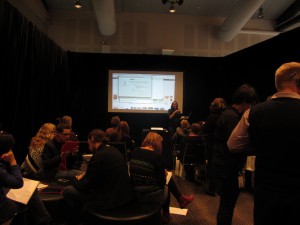 Australia’s largest learning difficulties event attracted the crowds at Rosehill Gardens in Sydney. According to Learning Difference Convention director, Jillian Zocher, the convention was twice as busy as the inaugural event last year with positive feedback from both delegates and exhibitors.
Australia’s largest learning difficulties event attracted the crowds at Rosehill Gardens in Sydney. According to Learning Difference Convention director, Jillian Zocher, the convention was twice as busy as the inaugural event last year with positive feedback from both delegates and exhibitors.
Teachers and health professionals had plenty of opportunity to gather information on new products, services and educational support. There were seminars and free talks covering a diverse range of topics presented by international and local speakers.
One of the speakers, Albert Galaburda, Professor of Neurology and Neuroscience at the Harvard Medical School, believed Australia is lagging in its support for those with dyslexia.
“While I cannot confirm this, my first impression is that Australia is about three years behind the US in awareness and services available to dyslexic children,” he told F2L. However, he added that Australia was not alone in the developed world to be slow in dealing with dyslexia.
“In the US there are laws in place that obligate schools to provide services to students with dyslexia and there is plenty of evidence to show that these children can contribute immensely to society in an intellectual way.
“Not all dyslexic children can be like Albert Einstein, some are smart and some are not so smart. The first few years of education can be difficult but later many can overcome their difficulties, especially the bright ones, but it can be harder for the not so bright ones who don’t always make their way in the world, get a job and pay their taxes. They end up costing the government a lot more money than they would have if they had been given the support needed when they were younger. I get the sense Australia still has a fair way to go when it comes to taking care of these children. The problem is that governments and corporations don’t think about 20 years hence and there needs to be a different vision about investing in childcare and education. This strategy does not come with a short term payout but in the long term it does make a difference.”
As for a pharmacological solution, Professor Galaburda’s view is there is not one but hopefully there will be a pharmacological contribution. “There may be a pill developed to stabilise the brain and improve learning skills. But we also need the network of psychologists, special education teachers, educated parents and jobs to deal with the issues. After all we are talking about between 5 and 15 per cent of the population here.”
He said dyslexia may implicate dysfunction of several neural systems and the relative importance of these needed further clarification. “Although the cerebral cortex and its cognitive systems are crucial for cognitive functions in adults, more fundamental sensory and perceptual systems are important for learning skills in infants and children.” Imaging research has pointed out differences in brain participation in reading in dyslexic versus normal reading individuals, he said, “but these techniques underestimate the roles of the centres in the brainstem and thalamus, responsible for sensory and perceptual functions.”
Anatomical studies of the human brain point to the involvement of both the cerebral cortex and the underlying thalamus in dyslexia with animal models adding evidence to the roles these play in the dysfunction. “More recent animal findings have implicated the cochlear nucleus – a sensory acoustic centre – in the dyslexic dysfunction,” Professor Galaburda added.
Educational and developmental psychologist, Alistair Howitt-Marshall, said he is seeing a broad spectrum of children with dyslexia at his New South Wales Central Coast practice. Speaking to F2L at the convention, he said “it is a concern that large numbers of children are slipping through the net and going through the education system and not being identified with dyslexia.” However, the good news is that there are positive changes happening as more parents realise that the earlier the condition is picked up the better the outcome.”
According to Howitt-Marshall it would only take an appropriately trained teacher 15 minutes to pinpoint dyslexia in a child and early intervention is critical and should be done between the ages of four and five years. He said the NSW school system is becoming more pro-active in assisting students with learning difficulties with new online teacher training programs in place.
Howlitt-Marshall who is dyslexic, offers a range of assessment packages. An initial screening that takes about an hour can establish if dyslexia is indicated and a full diagnostic assessment is needed. His consultations are available to those aged from four years to adults, including college and university assessments. “Many parents that I see believe they may be dyslexic based on the their educational experience but have never been formally identified.”
For more information: dyslexiaperspective@gmail.com
